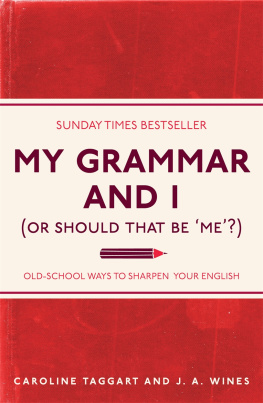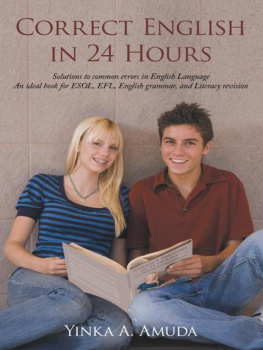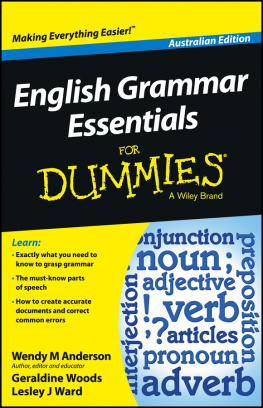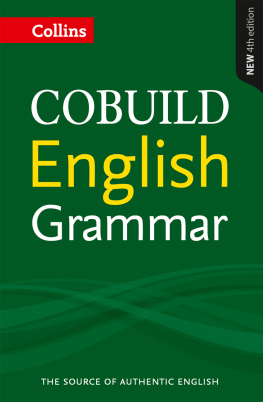ROUTLEDGE LIBRARY EDITIONS: THE ENGLISH LANGUAGE
Volume 18
PATTERN IN ENGLISH
Pattern in English
A Fresh Approach to Grammar
W. H. Mittins
First published in 1950
This edition first published in 2015
by Routledge
2 Park Square, Milton Park, Abingdon, Oxon OX14 4RN
and by Routledge
711 Third Avenue, New York, NY 10017
Routledge is an imprint of the Taylor & Francis Group, an informa business
1950 W. H. Mittins
All rights reserved. No part of this book may be reprinted or reproduced or utilised in any form or by any electronic, mechanical, or other means, now known or hereafter invented, including photocopying and recording, or in any information storage or retrieval system, without permission in writing from the publishers.
Trademark notice : Product or corporate names may be trademarks or registered trademarks, and are used only for identification and explanation without intent to infringe.
British Library Cataloguing in Publication Data
A catalogue record for this book is available from the British Library
ISBN: 978-1-138-92111-5 (Set)
ISBN: 978-1-315-68654-7 (Set) (ebk)
ISBN: 978-1-138-91711-8 (Volume 18) (hbk)
ISBN: 978-1-315-68923-4 (Volume 18) (ebk)
Publisher's Note
The publisher has gone to great lengths to ensure the quality of this reprint but points out that some imperfections in the original copies may be apparent.
Disclaimer
The publisher has made every effort to trace copyright holders and would welcome correspondence from those they have been unable to trace.
PATTERN IN ENGLISH
A FRESH APPROACH TO GRAMMAR
BY
W. H. MITTINS
B.A.
LONDON
GEORGE ALLEN & UNWIN LTD
FIRST PUBLISHED IN 1950
This hook is copyright under the Berne Convention.
No portion may be reproduced by any process without written permission. Inquiries should be addressed to the publishers
PRINTED IN GREAT BRITAIN
in 11 on 12 pt. Baskerville type
AT THE UNIVERSITY PRESS
ABERDEEN
This book includes what seems to me the minimum of English grammar relevant to efficient communication in language. The scope was determined by collecting from children's writings examples of common faults and weaknesses susceptible of treatment in grammatical terms. Certain concepts emerged as fundamentalpredication, word-order, proximity, equivalents, variety and repetition. Other notions helped towards the clear exposition of these fundamentalsparts of speech, phrases, clauses, link-words. Some time-honoured ideasnotably the classification of the parts of speech into categories: concrete and abstract nouns, demonstrative and possessive adjectives, and so on-seemed unnecessary.
Apart from a few matters relegated to appendices, this material is organised on a simple plan which, while easy for reference, provides a progressive course, leading from the structure of the simple sentence to problems of literary style.
The Simple Sentence is shown to be an assembly, according to one of a well-defined range of patterns, of various items. These items are certain Parts of Speech or their equivalents. Equivalents include other Parts of Speech (acting, as it were, out of character}, Phrases, and Clauses.
The assembling of the items involves the principle of Proximity and the use of Conjunctions and other link-words. The notions of Co-ordination and Sub-ordination and the earlier reference to Clauses as Equivalents lead to an examination of Multiple Sentences, with their Main and Subordinate Clauses.
Finally, the various word-clusters (Phrases and Clauses) are seen at work in passages from competent authors. The stylistic principles of emphasis, variety and repetition are associated with the distribution of phrases and clauses in consecutive prose.
To keep the central sequence of the argument clear, some important considerations are denied separate treatment. There are not, for instance, separate chapters on the Parts of Speech. A few minor points-Person and Number, for instance-are not introduced in the text at all, but in the exercises.
There are, I suppose, never enough exercises in a text-book. The teacher should have no difficulty, however, in expanding those given here. It is to be hoped, moreover, that they will be linked with an examination both of the pupils' own writing and of the literature being studied.
The practical core of the exercises is analysis. Some teachers deplore the schematic approach. Others who like schemes have their own favourite systems. The stencil method outlined in is, I believe, original and may appeal to those who, like myself, find that the more popular systems fail effectively to expose the bare bones of a sentence. Not wishing, nevertheless, to dogmatise in so controversial a matter, I have confined the stencil suggestion to an appendix, to which unobtrusive references are made in the course of the text.
Opinions vary considerably as to the age at which grammar should be taught. I have aimed primarily at the middle and upper forms of grammar schools. But, suitably diluted, the book should be usable both by junior grammar school forms and by other secondary pupils. A fair amount of guidance from teachers is assumed, but older students-in evening classes, for instance-should be able to manage unaided.
W. H. M.
Acknowledgement is due to the following for permission to use copyright material:
Mr. John Farquharson, for extract from Thomas Burke's Old Joe.
Messrs. Cassell & Co., Ltd., and the author, for extracts from Winston Churchill's War Memoirs, Volume 2.
Messrs. Longmans, Green & Co., Ltd., and the author, for extract from Professor G. M. Trevelyan's English Social History.
Mr. A. D. Peters and the author, for extract from Hilaire Belloc's First and Last.
Messrs. Cassell & Co., Ltd., for extract from G. K. Chesterton's Three Tools of Death.
Messrs. J. M. Dent & Sons, Ltd., for extract from Joseph Conrad's Touth.
Dr. John Masefield, O.M., and the Society of Authors, for extract from A Tarpaulin Muster.
Messrs. Longmans, Green & Co., Ltd., for extract from Lieut.-Colonel Henderson's Stonewall Jackson.
I must also thank Miss Nancy Martin, Lecturer on the Teaching of English at London University Institute of Education, for a number of most helpful criticisms and suggestions.
Contents
Part One
Simple Sentences
Cha pter I
Sentence and Predication
Read this passage aloud:
As I reached the inn door I heard voices raised in angry argument. I hesitated a moment. Then I gently pushed the door open and peered in. The room was crowded. A tall strong man, with a tarry pigtail hanging over his shoulders. The landlord was crouching in the corner.
Correct the statement that sounds wrong, by adding to it.
Exercise
Similarly, make sentences of the following:
- The house on top of the hill near Dunscombe...
- The mudguards of the dilapidated old bicycle...
- Novels like the Biggies series by Capt. W. E. Johns...
- Tigers, leopards and cheetahs...
- The railings round the football ground...
- Mr. Winston Churchill...
- Coal-miners, whose work is very hard and unpleasant,...
- Feeling weary after his long day in the hot sun, John...
- One of the drawbacks of fishing as a pastime...
- The man to whom Captain Flint gave his sea-chest when he was dying at Savannah...












